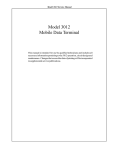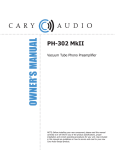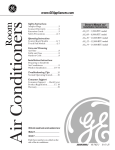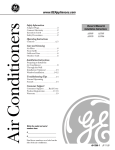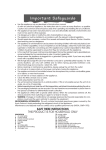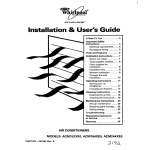Download Seabreeze WA24ZM Specifications
Transcript
WINDOW AIR CONDITIONER INSTALLATION AND OPERATION CATALOG NO. WA18ZR WA24ZR PRODUCT CODE 420-0068 420-0071 950-0052-revB CATALOG NO. PRODUCT CODE WA24ZM 420-0072 1-10-07 Page 1 of 17 TABLE OF CONTENTS AIR CONDITIONER SAFETY………………………………………………….….2 INSTALLATION REQUIREMENTS………………………………………………3 INSTALLATION INSTRUCTIONS………………………………………………..5 THRU-THE-WALL CABINET INSTALLATION…………………………………9 AIR CONDITIONER USE…………………………………………………………11 AIR CONDITIONER CARE……………………………………………………….13 TROUBLESHOOTING………………………………………………………….…14 SPECIFICATIONS…………………………………………………………………16 WARRANTY………………………………………………………………………...17 TECHNICAL SUPPORT IF YOU NEED TECHNICAL SUPPORT, PLEASE CALL (705) 504-8590 BETWEEN THE HOURS OF 8:00 A.M. and 5:00 P.M. EST. PLEASE HAVE THE MODEL NUMBER AND SERIAL NUMBER OF YOUR EQUIPMENT AVAILABLE WHEN YOU CALL. AIR CONDITIONER SAFETY Your safety and the safety of others is very important We have provided many important safety messages in this manual and on your appliance. Always read and follow all safety instructions. This is the safety alert symbol. This symbol alerts you to potential hazards that can kill or hurt you or others. All safety messages will follow the safety alert symbol and the word “DANGER” or “WARNING”. These words mean: You can be seriously injured if instructions are not followed. Bodily injury or damage to personal property may occur if instructions are not followed. All safety messages will tell you what the potential hazard is, tell you how to reduce the chance of injury, and tell you what can happen if the instructions are not followed. Page 2 of 17 IMPORTANT SAFETY INSTRUCTIONS WARNING: To reduce the risk of fire, electrical shock or injury when using your air conditioner, follow these basic precautions: • • • • • • Plug into a grounded 3 prong outlet. Do not remove ground prong. Do not use an adapter. Do not use an extension cord. Unplug Air Conditioner before servicing. Use two or more people to move and install air conditioner. ___________________________________________________________________________________________ INSTALLATION REQUIREMENTS ________________________________________ ________________________________________ Location Requirements Tools and Parts IMPORTANT: Observe all governing codes and Gather the required tools and parts before starting ordinances. installation. Check the location where air conditioner will be Read and follow the instructions provided with any installed. Proper installation is your responsibility. tools listed here. Make sure you have everything necessary for correct installation. Tools Needed: The location should provide: Flat-blade and Phillips Screwdrivers Tape measure • Grounded electrical outlet within 4 ft (122 Drill and 3/16” or smaller bit cm) of where the power cord exits the air Level conditioner. NOTE: Do not use an extension cord. Parts supplied (on some models) • Free movement of air in room to be cooled. • A large enough opening for the air conditioner. • Adequate wall support for weight of air conditioner. Air conditioner weights between 145 and 200 lbs (65 to 96 kg). NOTE: Cabinet louvers must not be obstructed. Air must be able to pass freely through the cabinet louvers. NOTE: Installation parts are supplied for doublehung windows up to 40: (101.6cm) wide. Page 3 of 17 _____________________________________ WINDOW INSTALLATION _____________________________________ Window Opening Measurements: • 30” min to 40” max. opening width. • 20” Min. opening height. _____________________________________ Electrical Requirements _____________________________________ Recommended Grounding Method This air conditioner must be grounded. This air conditioner is equipped with a power supply cord having a grounded 3 prong plug. To minimize possible shock hazard, the cord must be plugged into a mating, grounded 3 prong outlet, grounded in accordance with all local codes and ordinances. If a mating outlet is not available, it is the customer’s responsibility to have a properly grounded 3 prong outlet installed by a qualified electrical installer. It is the customer’s responsibility: • To contact a qualified electrical installer. • To assure that the electrical installation is adequate and in conformance with National Electrical Code, ANSI/NFPA 70- latest edition, and all local codes and ordinances. Copies of the standards listed may be obtained from: National Fire Protection Association One Batterymarch Park Quincy, MA 02269 _____________________________________ Power Supply Cord _____________________________________ NOTE: Your unit’s device may differ from the ones shown. This room air conditioner is equipped with a power supply cord required by UL. This power supply cord contains state-of-the-art electronics that sense leakage current. If he cord is crushed, the electronics detect leakage current and power will be disconnected in a fraction of a second. Page 4 of 17 To Test your power supply cord: 1. Plug power supply cord into a grounded 3 prong outlet. 2. Press RESET 3. Press TEST (listen for click, Reset button will trip and pop out). 4. Press and release RESET (listen for click; Reset button will latch and remain in). The power supply cord is ready for operation. NOTES: • The reset button must be pushed in for proper operation. • The power supply cord must be replaced if it fails to trip when the test button is pressed or fails to reset. • Do not use the power supply cord as an off/on switch. The power supply cord is designed as a protective device. • A damaged power supply cord must be replaced with a new power supply cord obtained from the product manufacturer and must not be repaired. • The power supply cord contains no user serviceable parts. Opening the tamper-resistant case voids all warranty and performance claims. INSTALLATION INSTRUCTIONS ________________________________________________________________________________________ Unpacking 3. Remove the window lock bracket and screw from the air conditioner and set aside. Remove packaging materials • Remove and dispose of/recycle packaging materials. Remove tape and glue residue from surfaces before turning on the air conditioner. Rub a small amount of liquid dish soap over the adhesive with your fingers. Wipe with warm water and dry. • Do not use sharp instruments, rubbing alcohol, flammable fluids, or abrasive cleaners to remove tape or glue. These products can damage the surface of your air conditioner. • Handle air conditioner gently. 1. Remove the air conditioner from the carton and place it on cardboard. 2. Remove shipping screws from the rear of the cabinet. 4. Remove the ground screw and ground wire from the front of the air conditioner base. Save the ground screw. 5. Pull on handles to slide air conditioner out of cabinet. Place air conditioner on cardboard. NOTE: Do not push, pull or remove any expanded polystyrene (foam) from inside the air conditioner. It is not packing material. Page 5 of 17 ________________________________________________________________________________________ Window Installation (on some models) NOTES: • Handle air conditioner gently. • Be sure your air conditioner cabinet does not fall out of the opening during installation or removal. • The place where the power cord exits the air conditioner should be no more than 4 ft (122 cm) from a grounded 3 prong outlet. • Do not block the louvers on the front panel. • Do not block the louvers on the outside of the air conditioner. • Attach Top Channel NOTE: Attach top channel and side curtains to air conditioner cabinet before placing cabinet in window. • Locate provided bag of screws. • Place top channel on top of air conditioner cabinet, lining up the 4 holes in top channel with the 4 holes on top of air conditioner cabinet. • Using 4 - #10 x 3/8” washer-head Phillips thread cutting screws, attach top channel to air conditioner cabinet. Extend right-hand curtain outward so you may insert the first screw through the middle hole of the curtain. Using #10 x ¼” pan-head Philips screw, screw curtain to middle hole in air conditioner cabinet. NOTE: This screw is required to correctly attach curtain (top to bottom) to the air conditioner cabinet. • Attach Side Curtains • Locate provided bag of screws. • Insert top and then bottom of right-hand curtain housing in top and bottom curtain channels on air conditioner. Page 6 of 17 While the right-hand curtain is still extended, insert #10 x ¼” pan-head Phillips screws into the top and bottom slots of curtain. Screw curtain to the top and bottom holes in the air conditioner cabinet. • Slide the curtain housing into the curtain channels as far as it will go. • Repeat above steps for the left hand curtain. Attach foam adhesive seal Attach foam adhesive seal along the bottom of the curtain bottom channel. Install Cabinet into Window Attach Side Curtains to Window Frame • • 1. Pull Left-hand curtain out until it fits into window channel. Use a 3/32” drill bit to drill a starter hole through the hole in the curtain housing and into the lower window sash. Handle air conditioner gently. Be sure your air conditioner cabinet does not fall out of the opening during installation or removal. • The place where the power cord exits the air conditioner should be no more than 4 ft (122 cm) from a grounded 3 prong outlet. • Do not block the louvers on the front panel. • Do not block the louvers on the outside of the air conditioner. 1. Center empty cabinet in window. Check that lower rail of air conditioner cabinet is behind and against back side of windowsill. Maintain a firm hold on the air conditioner cabinet. Lower window sash to hold cabinet in place. 2. Measure the distance between the righthand side of the cabinet and the inside of the window channel. 3. Repeat for the left side. Adjust the cabinet until the distance on each side is the same. 2. Insert one of the #10 x ¾” round-head screws through the threaded hole in the top of the curtain. 4. use a 3/16” drill bit to drill 4 starter holes 3/8” deep- through the 4 holes in the cabinet and into the windowsill. 5. Attach cabinet to windowsill with 4 - # 10 x ½” pan-head Phillips screws. 3. Repeat for right-hand curtain. 1. Attach support Brackets Attach support brackets to the cabinet by aligning the holes in the bracket with the holes in the cabinet. 6. Check that air conditioner cabinet is tilted to the outside so that water will run to the outside. Page 7 of 17 2. Insert air conditioner into cabinet. 2. Using #10 x 7/8” pan-head Phillips screws, attach bracket to cabinet. Repeat for other bracket. 3. Turn the adjustment bolt for each bracket until the bolt touches the wall. 4. Turn the locking nut on adjustment bolt to lock in positions. 3. Connect green ground wire to cabinet base with ground screw. Position ground wire pointing straight up. Put excess ground wire between coil and air conditioner cabinet. 4. Push Front panel straight on and then lower it slightly to lock it into place. Complete Installation 1. Insert seal behind the top of the lower window sash and against the glass of the upper window. 2. Place one window-lock bracket on top of lower window and against upper window sash on each side of window. 3. Use a 3/32” drill bit to drill starter holes through the holes in each bracket into the window sash. 4. Attach both window-lock brackets to window sash with a #10 x ¾” round-head screw to secure window in place. Final Installation NOTE: 1. Make sure the free end of the ground wire is outside of the cabinet. Page 8 of 17 5. Using 2 # 10 x 3/8” round head screws, attach bottom of front panel. Through-the-Wall Cabinet Installation NOTES: • Use 1” (2.5cm) or thicker lumber for wood frame. • Handle air conditioner gently. • Be sure your air conditioner does not fall out of 4. Apply wood preservative to the outside the opening during installation or removal. exposed surfaces. • The place where the power cord exits the air conditioner should be no more than 4 ft (122cm) from a grounded 3 prong outlet. • It is the customer’s responsibility and obligation to have this product installed by a qualified technician familiar with through-thewall room air conditioner installations. • Do not block the louvers on the front panel. • Do not block the louvers on the outside of the air conditioner. Option 1 – Wood, Metal or Plastic molding When using a wood, metal or plastic molding, the 5. Insert the frame in the wall opening. Square wood frame should line up with inside wall as shown, and level frame. 6. Attach frame securely to the wall. INSTALL CABINET INTO WOOD FRAME 1. Remove top channel and both side channels using a ¼” nut driver or socket wrench. Discard top channel and both side channels. Option 2 – Plastered wall with no molding If the plastered wall is to be flush with the cabinet and no molding used, the wood frame must be set ½” 913mm) into the inside wall. Install Wood Frame 1. Construct wood frame. See “Location Requirements” for dimensions. 2. Measure outside width and height of frame to determine wall opening dimensions. 3. Cut opening through the wall. Remove and save insulation. • Dimension for depth depends on wall thickness and type of molding. • Do not block louvers in air conditioner cabinet. Page 9 of 17 2. Insert cabinet into the framed wall opening. The top of the cabinet should extend ¾” (19.1 mm) into the room. If there is trim, the cabinet should extend ¾” (19.1mm) past the trim. 3. Use a level to check that the unit is level side to side. 4. Check that air conditioner cabinet is tilted to the outside so that water will run to the outside. 5. Reuse the insulation to seal opening between cabinet and frame. 6. Use existing holes in sides and top of cabinet and 7 #10 x 1” wood screws (not provided) to attach cabinet to frame. NOTE: Do not over-tighten screws or cabinet will distort and provide a poor seal between cabinet and air conditioner. 7. Caulk all outside wall openings around cabinet. Complete Installation 1. Insert seal behind the top of the lower window sash and against the glass of the upper window. 2. Place one window-lock bracket on top of lower window and against upper window sash on each side of window. 3. Use a 3/32” drill bit to drill starter holes through the holes in each bracket into the window sash. 4. Attach both window-lock brackets to window sash with a #10 x ¾” round-head screw to secure window in place. Final Installation NOTE: 5. Make sure the free end of the ground wire is outside of the cabinet. Page 10 of 17 6. Insert air conditioner into cabinet. 7. Connect green ground wire to cabinet base with ground screw. Position ground wire pointing straight up. Put excess ground wire between coil and air conditioner cabinet. 8. Push Front panel straight on and then lower it slightly to lock it into place. 9. Using 2 # 10 x 3/8” round head screws, attach bottom of front panel. AIR CONDITIONER USE 1. Operating your air conditioner properly helps you obtain the best possible results. This section explains proper air conditioner operation IMPORTANT: • If you turn off the air conditioner, wait at least 3 minutes before turning it back on. This prevents the air conditioner from blowing a fuse or tripping a circuit breaker. • Do not try to operate your air conditioner in the cooling mode when outside temperature is below 65ºF. The inside evaporator coil will freeze up, and the air conditioner will not operate properly. NOTE: In the event of a power failure, your air conditioner will operate at the previous settings when the power is restored. Touch Control Panel Lights next to the touch pads on the air conditioner control panel indicate the selected settings. Air Conditioner Controls Power pad – Turns the air conditioner on and off. When turned on, the display will show the room temperature. 2. Display – Shows the room temperature or time remaining on the Delay timer. Shows the Set temperature while setting the temperature in Cool or Energy Saver modes. The Set light will turn on while setting. NOTE: The display will change to show the room temperatures after settings have been made. To recall the Set temperature, press the Temp Increase or Decrease pads. 3. Increase “▲”pad – Used to increase set temperature when in Cool or Energy Saver mode. The Set light will turn on while setting. Used to increase the delay time when using the Timer function. 4. Decrease “▼” pad –Used to decrease set temperature when in Cool or Energy Saver mode. The Set light will turn on while setting. Used to decrease the delay time when using the Timer function. 5. Fan Speed pad – Used to select the fan speed. The lights marked “High”, “Med”, or “Low” will illuminate to indicate which fan speed is selected. 6. Mode pad – Used to select between Fan only or Cool mode of operation. In the Fan only mode, since Fan only settings do not provide cooling, a Set temperature can not be entered. The display will indicate the room temperature. 7. Circulaire pad – Used to turn on the side-to-side air circulation. For fixed side-to-side air direction, turn on until the desired air direction is obtained, then turn off. Model WA18ZR 8. Timer/Delay pad – Used to select the amount of time before the air conditioner turns off (when on), or the amount of time before the air conditioner turns on (when off). Programmable in 1 hour increments from 1 to 24 hours. How to set the Timer: Delayed “ON”; Air Conditioner must be off. Press the Timer/Delay button. The Timer/Delay light will turn on and the display will indicate the number of hours before the air conditioner will turn on. To change the time before turn on, press the Increase “▲” or Decrease “▼” pads until the desired number of hours before turn on is reached (1 to 24 hrs). Model WA24ZR Page 11 of 17 Delayed “OFF”: Air Conditioner must be on. Press Timer/Delay button. The Timer/Delay light will turn on and the display will indicate the number of hours before the air conditioner will turn off. To change the time before turn off, press the Increase “▲” or Decrease “▼” pads until the desired number of hours before turn on is reached (1 to 24 hrs). To review the amount of time remaining on the timer, press the Timer/Delay pad one time. If you desire to increase or decrease the amount of time remaining, use the Increase “▲” or Decrease “▼” pads to set a new time. To cancel the Timer, press the Timer/Delay pad until the Timer/Delay light extinguishes. the Energy Saver mode off, and the fan runs all the time, while the compressor cycles on and off. 10. Fan Only Mode: Use the Fan Only Mode at Low, Med or High fan speed to provide air circulation and filtering without cooling, a Set temperature cannot be entered. The room temperature will appear in the display. NOTE: Auto Fan Speed cannot be used when in the Fan Only Mode. 11. Auto Fan Speed: Set to Auto fan speed for the fan speed to automatically set to the speed needed to provide optimum comfort settings with the set temperature. If the room needs more cooling, the fan speed will automatically increase. If the room needs less cooling, the fan speed will automatically decrease. NOTE: Auto Fan Speed cannot be used when in the Fan Only Mode. 9. Energy Saver pad – used to control the fan. When the Energy Saver pad is pressed, the Energy Saver light comes on, and the fan will cycle on and off with the compressor. This results in wider variations of room temperature and humidity. Normally used when the room is unoccupied. NOTE: The fan may continue to run for a short period of time after the compressor cycles off. Pressing the Energy Saver pad a second time turns ____________________________________________________________________________________________ REMOTE CONTROL OPERATION NOTE: • Be sure that there are no obstructions between the receiver and the remote controller. • Do not drop or throw the remote controller. • Do not let any liquid in the remote controller or put the remote controller under direct sunlight or any place where it is very hot. • Replace two AAA batteries once a year, or as required. Model WA18ZR Model WA24ZR Page 12 of 17 ____________________________________________________________________________________________ Manual Controls Features and appearance may vary. Model WA24ZM Controls The air conditioner controls are located behind the control panel doors. Press to open and close the door. For Quieter & Nighttime Cooling – Select Low Cool with the TEMPERATURE control at midpoint. TEMP Control The TEMP control is used to maintain the room temperature. The compressor will cycle off and on to keep the room at the same level of comfort. When you turn to the knob to a higher number, the indoor air will become cooler. Turn the knob to a lower number and the indoor air will become warmer. Mode Control High Cool, Med Cool and Low Cool Provide cooling with different fan speeds. High Fan and Low Fan settings provide air circulation and filtering without cooling. NOTE: if you move the mode control from a cool setting to OFF or to a fan setting, wait at least 3 minutes before switching back to a cool setting. CIRCULAIRE Cooling Descriptions For continuous side-to-side air circulation, set the Circulair switch to ON. For Normal Cooling – Select High Cool or Med Cool with the TEMPERATURE control at midpoint. For fixed side-to-side air direction, set the Circulaire switch to ON until the desired air direction is obtained, then move it to OFF. For Maximum Cooling – Select High Cool with the TEMPERATURE control at the highest number available on you knob. ____________________________________________________________________________________________ AIR CONDITIONER CARE Your new air conditioner is designed to give you 1. Turn off the air conditioner. many years of dependable service. This section tells 2. Remove air filter by sliding filter out from either you how to clean and care for your air conditioner side of unit. properly. Call your local authorized dealer for an annual checkup. Remember, the cost of this service call is your responsibility. __________________________________________ Cleaning the Air Filter The air filter is removable for easy cleaning. A clean filter helps remove dust, lint, and other particles from the air and is important for best cooling and operating efficiency. Check the filter every 2 weeks to see whether it needs cleaning. NOTE: Do not operate the air conditioner without the filter in place. Page 13 of 17 3. Use a vacuum cleaner to clean air filter. If air filter is very dirty, wash it in warm water with a mild detergent. Do not wash air filter in the dishwasher or use any chemical cleaners. Air dry filter completely before replacing to ensure maximum efficiency. 4. Replace air filter by sliding filter back into either side of unit. __________________________________________ Cleaning the Front Panel 1. Turn off the air conditioner 2. Remove the air filter and clean it separately. See Cleaning the Air Filter. 3. Wipe the front panel with a soft damp cloth. 4. Air dry front panel completely. Repairing Paint Damage Check once or twice a year for paint damage. This is very important, especially in areas near oceans or where rust is a problem. If needed, Touchup with a good grade enamel paint. NOTE: To reduce paint damage during the winter, install a heavy duty cover over the air conditioner cabinet. __________________________________________ Annual Maintenance Your air conditioner needs annual maintenance to help ensure steady, top performance throughout the year. Call your local authorized dealer to schedule an annual checkup. The expense of an annual inspection is your responsibility. ____________________________________________________________________________________________ TROUBLESHOOTING Before calling for service, try the suggestions below to see whether you can solve your problem without outside help. __________________________________________ __________________________________________ Air conditioner will not operate Air conditioner blows fuses or trips circuit breakers __________________________________________ Too many appliances are being used on the same circuit. Unplug or relocate appliances that share the same circuit. Time-delay fuse or circuit breaker of the wrong capacity is being used. Replace with a time-delay fuse or circuit breaker of the correct capacity. See “Electrical Requirements”. An extension cord is being used. Do not use an extension cord with this or any other appliance. The power supply cord is unplugged. Plug into a grounded 3 prong outlet. See “Electrical Requirements”. The power supply cord has tripped (Reset button has popped out). Press and release RESET (listen for click; Reset button will latch and remain in) to resume operation. A household fuse has blown, or a circuit breaker has tripped. Replace the fuse or reset the circuit breaker. If the problem continues, call an electrician. See “Electrical Requirements”. Depending on model, the Power button has not been pressed or the Fan control is turned to OFF. Press POWER or turn the Fan control to an active setting. The local power has failed. Wait for power to be restored. You are trying to restart the air conditioner too soon after turning the unit off. Wait at least 3 minutes after turning the unit off before trying to restart the air conditioner. __________________________________________ Air Conditioner power supply cord trips (Reset button pops out) __________________________________________ Disturbances in your electrical current can trip (Reset button will pop out) the power supply cord. Press and release RESET (listen for click; Reset button will latch and remain in) to resume operation. Electrical overloading, overheating, pinched cord can trip (Reset button will pop out) the power supply cord. After correcting the problem, press and release RESET (listen for click; Reset button will latch and remain in) to resume operation. NOTE: a damaged power supply cord must be replaced with a new power supply cord obtained from the product manufacturer and must not be repaired. Page 14 of 17 __________________________________________ Air conditioner seems to run too much __________________________________________ The current air conditioner replaced an older model. The use of more efficient components may cause the air conditioner to run longer than an older model, but the total energy consumption will be less. Newer air conditioners do not emit the blast of cold air you may be accustomed to from older units, but this is not an indication of lesser cooling capacity or efficiency. Refer to the efficiency rating (EER) and capacity rating (in BTU/hr.) marked on the air conditioner. The louvers are blocked. Install the air conditioner in a location where the louvers are free from curtains, blinds, furniture, etc. The air conditioner is in a heavily occupied room, or heat-producing appliances are in use in the room. Use exhaust vent fans while cooking or bathing and try not to use heat producing appliances during the hottest part of the day. A higher capacity air conditioner may be required, depending on the size of the room being cooled. __________________________________________ Air Conditioner cycles on and off too much, or does not cool/heat room in cooling/heating mode __________________________________________ The mode of Fan control is set to Power Saver (on some models). Use Power Saver only when you are asleep or away from home, since the fan does not circulate the room air continuously. Use Low Cool, High Cool, or Turbo Cool for your best comfort. Windows or doors to the outside are open. Close all windows and doors. The air conditioner is not properly sized for your room. Check the cooling capabilities of your room air conditioner. Room air conditioners are not designed to cool multiple rooms. The filter is dirty or obstructed by debris. Clean the filter. The inside evaporator and outside condenser coils are dirty or obstructed by debris. See “Annual Maintenance. There is excessive heat or moisture (open container cooking, showers, etc.) in the room. Use a fan to exhaust heat or moisture from the room. Try not to use heat-producing appliances during the hottest part of the day. The outside temperature is below 65ºF (18ºC). Do not try to operate your air conditioner in the cooling mode when the outside temperature is below 65ºF (18ºC). The temperature of the room you are trying to cool is extremely hot. Allow extra time for the air conditioner to cool off a very hot room. The Vent control is set to OPEN (on some models). Push the Vent control to CLOSED for maximum cooling and/or heating. The temperature set point or Thermostat control is not at a cool enough setting. Adjust the temperature set point to a cooler setting by pressing the minus button to reduce the temperature or adjust the Thermostat control to a cooler setting by turning the knob clockwise. Turn the Fan control to HIGH or Turbo Cool. __________________________________________ Temperature on display does not match room temperature __________________________________________ When the compressor and fan motor turn off during Power Saver mode, or after you turn off the unit, a lower temperature reading than the actual room temperature may be displayed for a short period of time. This lower temperature reading is caused by the temperature sensor being located close to the cold evaporator coil. The actual room temperature will display within a few minutes. __________________________________________ Water drips from cabinet into your house __________________________________________ The air conditioner is not properly leveled. The air conditioner should slope slightly downward toward the outside. Level the air conditioner to provide a downward slope toward the outside to ensure proper drainage. See the Installation instructions. NOTE: Do not drill a hole into the bottom of the metal base and condensate pan. Page 15 of 17 TECHNICAL SPECIFICATIONS MODEL BTU Cooling BTU Heating EER Dehumidification (Pints/Hour) Airflow (cfm) Voltage Amps Cooling Amps Heating Watts Cooling Watts Heating Plug Type Power Cord Rating (amps) Power Cord Type Power Cord Length Refrigerant Refrigerant Charge (oz. / lbs) Sound Level (Inside / Outside) dba (MAX) 4 Way Air Adjustment 2 Way Air Swing Air Discharge Motor Type Motor Capacitor Controls Ambient Operating Temperature Cabinet Size (Inches) Width Depth Height Window Opening Thru Wall Max Thickness Weight/Lbs (Gross / Net) Approvals WA18ZR 18,000 N/A 9.7 4.6 459 208/230 VAC 12.57 N/A 1810 / 1850 N/A Type C 20 LCDI 6’ R22 27.84 / 1.74 56 / 61 WA24ZR 24,000 N/A 8.5 6.5 618 208/230 VAC 13.1/12.1 N/A 2710 / 2740 N/A Type C 20 LCDI 6’ R22 33.44 / 2.09 56 / 61 WA24ZM 24,000 N/A 8.5 6.5 618 208/230 VAC 13.1/12.1 N/A 2710 / 2740 N/A Type C 20 LCDI 6’ R22 33.44 / 2.09 56 / 61 YES YES SIDE Ball Bearing 7 µfd Remote 64ºF TO 109ºF YES YES SIDE Ball Bearing 7 µfd Remote 64ºF TO 109ºF YES YES SIDE Ball Bearing 7 µfd Mechanical 64ºF TO 109ºF 26” 27 7/8” 16 7/8” 30” – 46” 8 ½” 163 / 150 UL/CUL 26” 30 ½” 17” 30” – 46” 8 ½” 183 / 165 UL/CUL 26” 30 ½” 17” 30” – 46” 8 ½” 183 / 165 UL/CUL Page 16 of 17 WARRANTY International Refrigeration Products warrants that the product supplied is free from defects in material and workmanship. This warranty is valid as long as this product is properly handled, installed, operated and serviced in accordance with the Installation and Operating Instructions shipped with this unit, and the warranty card is completed and mailed no later than 30 days after date of purchase. All warranty claims must be made within one (1) year (five (5) years for compressor) from date of purchase (unless national regulations require a longer registration period). This warranty provides free replacement of defective parts only. Labor, and replacement parts as a result of normal wear and tear are not covered under this warranty. Additional claims are excluded, unless required by national regulations. International Refrigeration Products Inc. is not responsible for incidental, consequential, direct, or indirect damages or expenses relating to the use of, or the inability to use the product for any purpose. Other implied warranties are excluded. This constitutes International Refrigeration Products warranty obligation and replaces any and all prior warranties for this product. INTERNATIONAL REFRIGERATION PRODUCTS INC. 11325 Nations Ford Rd., Charlotte, NC 28134-8393 (704) 504-8590 Phone (704) 504-3023 Fax Copyright 2006 IRP Inc. 950-0052 Page 17 of 17




















